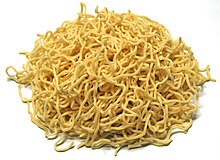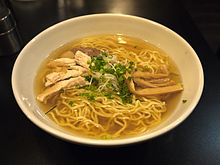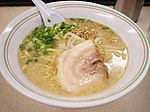History
Ramen is of Chinese origin; however, it is unclear when ramen was introduced to Japan. The etymology of ramen is a topic of debate. One theory is that ramen is the Japanese pronunciation of the Chinese lamian (拉麺),[3] meaning "hand-pulled noodles." A second theory proposes 老麺 (laomian, "old noodles") as the original form, while another states that ramen was initially 鹵麺 (lǔmiàn), noodles cooked in a thick, starchy sauce. A fourth theory is that the word derives from 撈麵 (lāomiàn, "lo mein"), which in Cantonese 撈 means to "stir", and the name refers to the method of preparation by stirring the noodles with a sauce.Until the 1950s, ramen was called shina soba (支那そば, literally "Chinese soba") but today chūka soba (中華そば, also meaning "Chinese soba") or just Ramen (ラーメン) are more common, as the word "支那" (shina, meaning "China") acquired a pejorative connotation.[4]
By 1900, restaurants serving Chinese cuisine from Canton and Shanghai offered a simple ramen dish of noodles (cut rather than hand pulled), a few toppings, and a broth flavored with salt and pork bones. Many Chinese also pulled portable food stalls, selling ramen and gyōza dumplings to workers. By the mid 1900s, these stalls used a type of a musical horn called a charumera (チャルメラ, from the Portuguese charamela) to advertise their presence, a practice some vendors still retain via a loudspeaker and a looped recording. By the early Shōwa period, ramen had become a popular dish when eating out.
After World War II, cheap flour imported from the U.S. swept the Japanese market. At the same time, millions of Japanese troops had returned from China and continental East Asia from their posts in the Second Sino-Japanese War. Many of these returnees had become familiar with Chinese cuisine and subsequently set up Chinese restaurants across Japan. Eating ramen, while popular, was still a special occasion that required going out.
In 1958, instant noodles were invented by Momofuku Ando, the Taiwanese-Japanese founder and chairman of Nissin Foods, now run by his son Koki Ando. Named the greatest Japanese invention of the 20th century in a Japanese poll,[5] instant ramen allowed anyone to make this dish simply by adding boiling water.
Beginning in the 1980s, ramen became a Japanese cultural icon and was studied around the world from many perspectives. At the same time, local varieties of ramen were hitting the national market and could even be ordered by their regional names. A ramen museum opened in Yokohama in 1994.[6]
Types
A wide variety of ramen exists in Japan, with geographical and vendor-specific differences even in varieties that share the same name. Ramen can be broadly categorized by its two main ingredients: noodles and broth.Noodles
Most noodles are made from four basic ingredients: wheat flour, salt, water, and kansui, which is essentially a type of alkaline mineral water, containing sodium carbonate and usually potassium carbonate, as well as sometimes a small amount of phosphoric acid. Originally, kansui was named after the water from Inner Mongolia's Lake Kan which contained large amounts of these minerals and was said to be perfect for making these noodles. Making noodles with kansui lends them a yellowish hue as well as a firm texture. Eggs may also be substituted for kansui. Some noodles are made with neither eggs nor kansui and should only be used for yakisoba.Ramen comes in various shapes and lengths. It may be fat, thin, or even ribbon-like, as well as straight or wrinkled.
Soup
Ramen soup is generally made from stock based on chicken or pork, combined with a variety of ingredients such as kombu (kelp), katsuobushi (skipjack tuna flakes), niboshi (dried baby sardines), beef bones, shiitake, and onions, and then flavored with salt, miso, or soy sauce. Other styles that have emerged later on include curry ramen and other flavors.The resulting combination is generally divided into four categories (although new and original variations often make this categorisation less clear-cut):
- Shio ("salt") ramen is probably the oldest of the four and is a pale, clear, yellowish broth made with plenty of salt and any combination of chicken, vegetables, fish, and seaweed. Occasionally pork bones are also used, but they are not boiled as long as they are for tonkotsu ramen, so the soup remains light and clear. Chāshū is sometimes swapped for lean chicken meatballs, and pickled plums and kamaboko are popular toppings as well. Noodle texture and thickness varies among shio ramen, but they are usually straight rather than curly.
- Tonkotsu (豚骨, "pork bone"; not to be confused with tonkatsu) ramen usually has a cloudy white colored broth. It is similar to the Chinese baitang (白湯) and has a thick broth made from boiling pork bones, fat, and collagen over high heat for many hours, which suffuses the broth with a hearty pork flavor and a creamy consistency that rivals milk, melted butter or gravy (depending on the shop). Most shops, but not all, blend this pork broth with a small amount of chicken and vegetable stock and/or soy sauce. The noodles are thin and straight, and it is often served with beni shoga (pickled ginger). In recent years the latest trend in tonkotsu toppings is māyu (sesame oil), a blackish, aromatic oil made from either charred crushed garlic or Sesame seeds. It is a specialty of Kyushu, particularly Hakata-ku, Fukuoka (hence sometimes called "Hakata ramen").
- Shōyu ("soy sauce") ramen typically has a clear brown broth, based on a chicken and vegetable (or sometimes fish or beef) stock with plenty of soy sauce added resulting in a soup that is tangy, salty, and savory yet still fairly light on the palate. Shōyu ramen usually has curly noodles rather than straight ones, but this is not always the case. It is often adorned with marinated bamboo shoots or menma, green onions, kamaboko (fish cakes), nori (seaweed), boiled eggs, bean sprouts and/or black pepper; occasionally the soup will also contain chili oil or Chinese spices, and some shops serve sliced beef instead of the usual chāshū.
- Miso ramen is a relative newcomer, having reached national prominence around 1965. This uniquely Japanese ramen, which was developed in Hokkaido, features a broth that combines copious amounts of miso and is blended with oily chicken or fish broth – and sometimes with tonkotsu or lard – to create a thick, nutty, slightly sweet and very hearty soup. Miso ramen broth tends to have a robust, tangy flavor, so it stands up to a variety of flavorful toppings: spicy bean paste or tōbanjan (豆瓣醤), butter and corn, leeks, onions, bean sprouts, ground pork, cabbage, sesame seeds, white pepper, and chopped garlic are common. The noodles are typically thick, curly, and slightly chewy.
Some restaurants also offer a system known as kae-dama (替え玉), where customers who have finished their noodles can request a "refill" (for a few hundred yen more) to be put into their remaining soup.[7]
Regional variations
While standard versions of ramen are available throughout Japan since the Taisho era, the last few decades have shown a proliferation of regional variations. Some of these which have gone on to national prominence are:Sapporo, the capital of Hokkaido, is especially famous for its ramen. Most people in Japan associate Sapporo with its rich miso ramen, which was invented there and which is ideal for Hokkaido's harsh, snowy winters. Sapporo miso ramen is typically topped with sweetcorn, butter, bean sprouts, finely chopped pork, and garlic, and sometimes local seafood such as scallop, squid, and crab. Hakodate,[8] another city of Hokkaidō, is famous for its salt flavored ramen, while Asahikawa,[9] in the north of the island, offers soy sauce flavored ones.
Kitakata in northern Honshu is known for its rather thick, flat, curly noodles served in a pork-and-niboshi broth. The area within its former city boundaries has the highest per-capita number of ramen establishments. Ramen has such prominence in the region that locally, the word soba usually refers to ramen, and not to actual soba which is referred to as nihon soba ("Japanese soba").
Tokyo style ramen consists of slightly thin, curly noodles served in a soy-flavoured chicken broth. The Tokyo style broth typically has a touch of dashi, as old ramen establishments in Tokyo often originate from soba eateries. Standard toppings on top are chopped scallion, menma, sliced pork, kamaboko, egg, nori, and spinach. Ikebukuro, Ogikubo and Ebisu are three areas in Tokyo known for their ramen.
Yokohama ramen specialty is called Ie-kei (家系). It consists of thick, straight-ish noodles served in a soy flavored pork broth similar to tonkotsu. The standard toppings are roasted pork (char siu), boiled spinach, sheets of nori, often with shredded Welsh onion (negi) and a soft or hard boiled egg. It is traditional for customers to call the softness of the noodles, the richness of the broth and the amount of oil they want.
Hakata ramen originates from Hakata district of Fukuoka city in Kyushu. It has a rich, milky, pork-bone tonkotsu broth and rather thin, non-curly and resilient noodles. Often, distinctive toppings such as crushed garlic, beni shoga (pickled ginger), sesame seeds, and spicy pickled mustard greens (karashi takana) are left on tables for customers to serve themselves. Ramen stalls in Hakata and Tenjin are well-known within Japan. Recent trends have made Hakata ramen one of the most popular types in Japan, and several chain restaurants specializing in Hakata ramen can be found all over the country.
|
Tokyo-style ramen
|
|
Kitakata ramen
|







Tidak ada komentar:
Posting Komentar